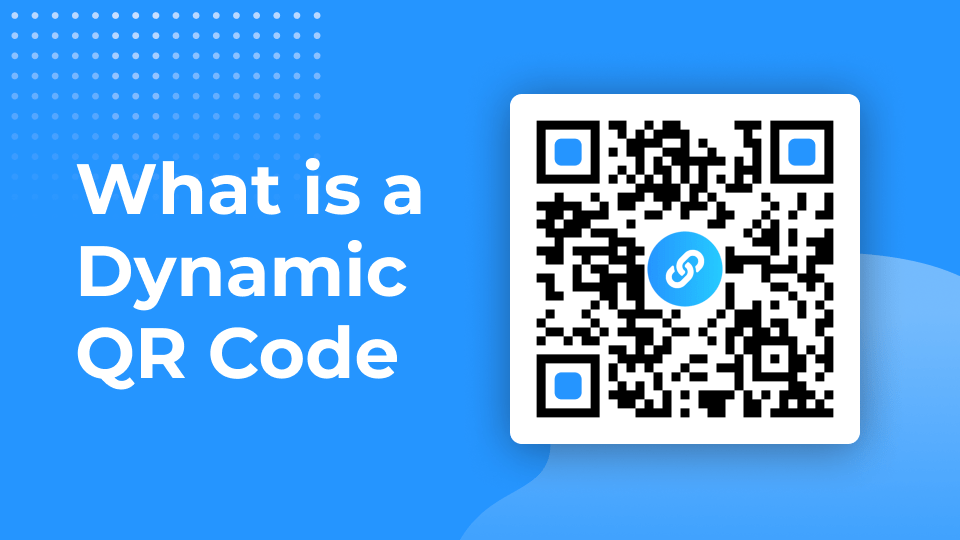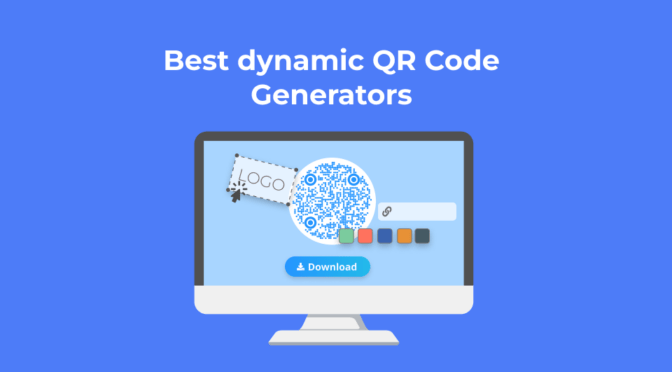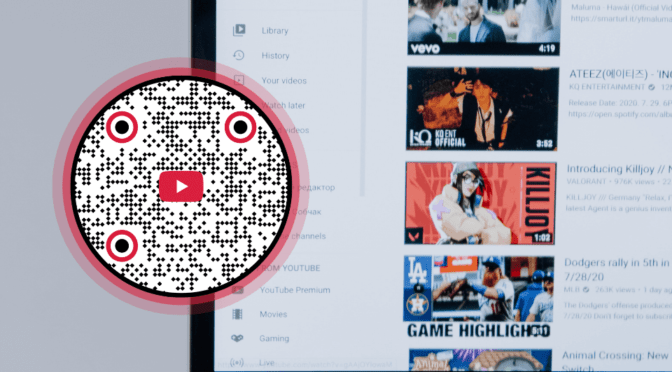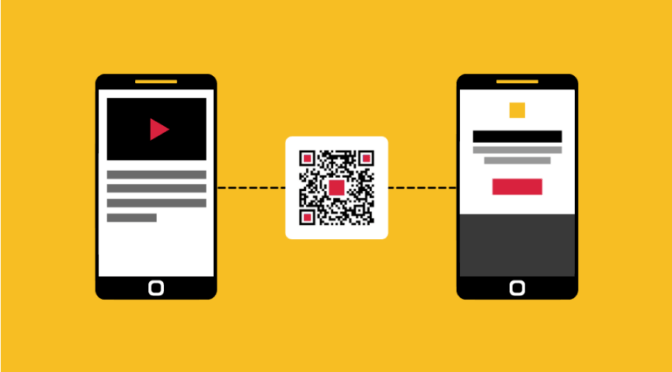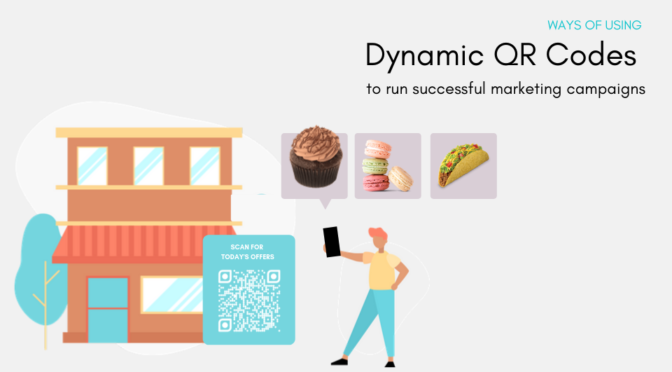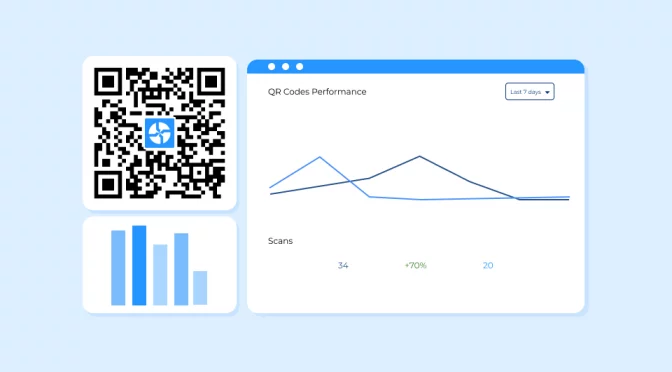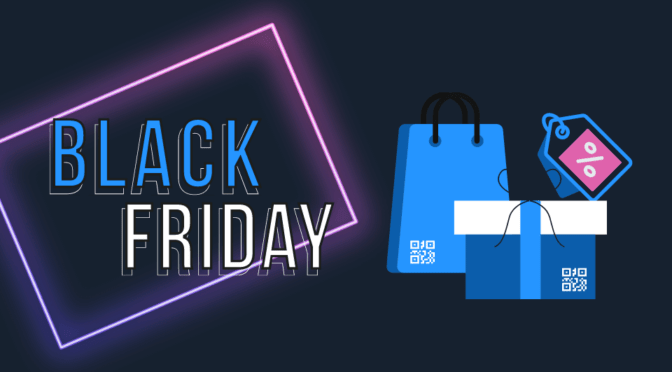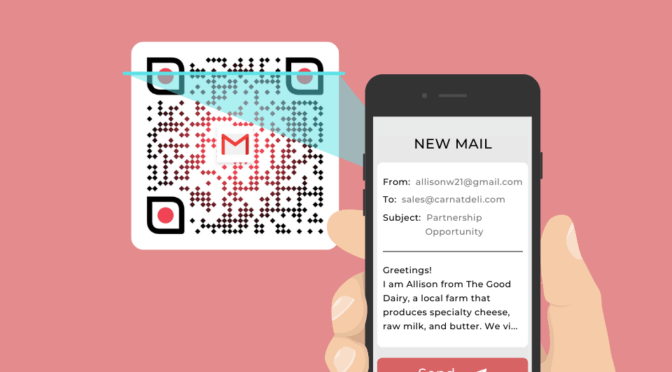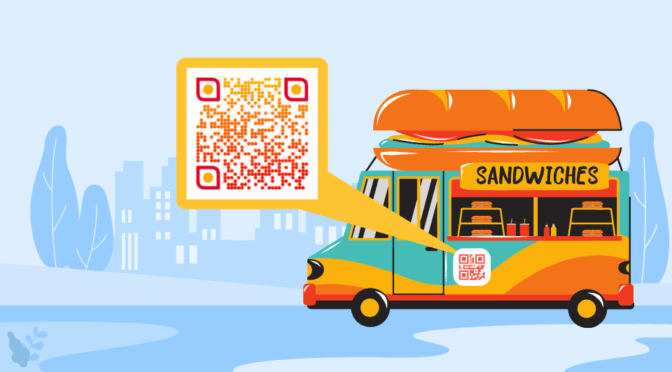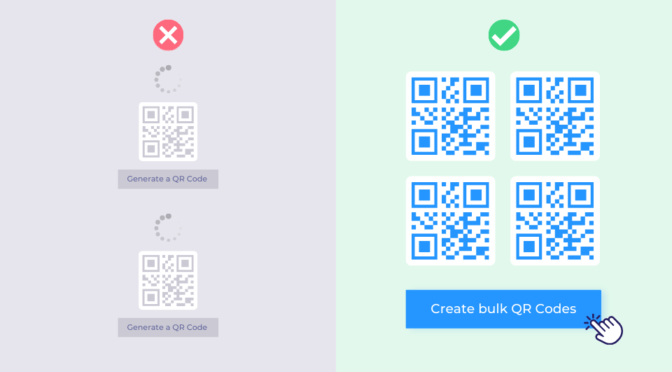💻 Key takeaways:
1. Dynamic QR Code is an editable QR Code that lets you change the content, is trackable and customizable
2. Their benefits over static QR Codes helps diverse industries share content via QR Codes for menus, app downloads, on brochures, billboards, etc.
3. Some best practices that help your dynamic QR Code be scannable at all times include: ensuring that the content is accessible at all times, the QR Code is branded, the right format is used, and the QR Code is tested before deploying,
Picture this: You’ve planned for a large advertising campaign with QR Codes. You plan to use them at a stadium, on a digital billboard where fans can scan and participate in a fun poll.
But when it actually gets screened, you realize there are disappointed fans staring at a 404 error on their mobile devices.
When you revisit the link, you find the source of the issue: a minor typo in the URL.
With no way to modify it now, you are left with a campaign that didn’t yield as much of a response as you had planned for.
With static QR Codes, this would be the situation. On the other hand, if you were to use dynamic QR Codes, you could’ve rectified this error with a simple ‘edit’ option, to redirect your audience to the right content.
Still wondering why dynamic QR Codes have the upper hand? That’s exactly what we delve into in this blog post.
Table of contents
- What is a dynamic QR Code?
- How do dynamic QR Codes work?
- How to create a dynamic QR Code?
- What are the benefits of dynamic QR Codes?
- How to make the most of dynamic QR Codes: Popular use cases
- Best practices to make your dynamic QR Code campaigns a success
- Frequently asked questions
What is Dynamic QR Code?
A Dynamic QR Code is an editable QR Code that lets you change the content or the destination URL even after creating or printing the QR Code. Static QR Codes do not have this feature.
Additionally, dynamic QR Codes also include beneficial features such as tracking QR Code scans, performance, and customizable QR Code designs.
Also read: All about static vs dynamic QR Codes
How do dynamic QR Codes work?
However, a dynamic QR Code works differently. Instead of pointing directly at the information, it points at a short URL. You can later decide where the short URL should redirect. This could be to your website, an online course, a landing page, etc.
Unlike static QR Codes, this mechanism of using a short URL allows dynamic QR Codes to be edited and updated even after being created.
How to create a dynamic QR Code?
Generating a dynamic QR Code is easy with Uniqode’s dynamic QR Code generator. You can also share varied content depending on your campaign or use case.
Step 1: Log in to the Uniqode dashboard and click “+Create”

To access the Uniqode dashboard, you can sign up for a free trial. Once you login to the dashboard, click “+create” and then “QR Codes”
Step 2: Choose the type of dynamic QR Code

You can use dynamic QR Codes to show varied content- from PDFs to landing pages.
Step 3: Insert the URL of the content

For instance, if you plan to share a PDF, you can choose the ‘PDF’ option and either upload the PDF or insert the URL if it is hosted online. Ensure to enable the sharing settings such that it is viewable by your audience.
Step 4: Customize the dynamic QR Code

You can customize the dynamic QR Code as per your branding:
- Customize the eyes and the eye shape
- Customize the data pattern, change its color, or add a gradient
- Go for a color background, add an image, or keep it transparent
- Add a QR Code border
- Add a CTA that provides a preview of where the QR Code leads to
Step 5: Download the dynamic QR Code in the format of your choice

You can download the dynamic QR Code in the format of your choice. If you plan to share it on printed materials, formats such as PNG and JPEG are recommended. For resizing purposes or usage on larger materials and screens, go for high-quality QR Code formats such as SVG and EPS.
💻 Tip: Using QR Codes on larger materials such as billboards subjects them to wear and tear due to conditions such as the weather, the geography of the area, etc. You can avoid the effects of any minor damage by enabling error correction. This ensures that your QR Codes function despite any damage to the pattern.
Uniqode’s QR Codes have error correction enabled by default. You can also opt for higher error correction levels by choosing the custom option and deciding the error correction level.
What are the benefits of dynamic QR Codes?
Dynamic QR Codes come with many benefits- and features that make them stand out among the limiting features of static QR Codes. These benefits include:
Benefit 1: Editability
Think of a coffee packet with a dynamic QR Code. This QR Code can link to cold coffee recipes in the summer, steaming cappuccino & mocha recipes in the winter! Basically, a dynamic QR Code empowers you with the flexibility to change QR Code destination or content as per your requirements.
Using a static QR Code, on the other hand, may just limit you to redirecting them to fixed content, such as a website or video, with no option to edit it later.
Benefit 2: Customization
Static QR Codes are known for their black-and-white look, but dynamic QR Codes are versatile. This is why they’re preferred by designers and brands alike. You get to choose the color, add a brand logo, a background image, or even add text below the QR Code.
All these elements ultimately make the QR Code interactive and enhance brand recall among your audience, nudging them to scan and view the content.
Did you know?🤔 Dynamic QR Codes scan faster compared to static QR Codes!
This is because dynamic QR Codes have shortened URLs converted into QR patterns. Given that the URL is short, the data patterns are not as dense as regular QR Codes. This makes it it easy for cameras and QR scanners to detect them, making your QR Codes look cleaner and amplifying consumer experience.
Benefit 3: Tracking
QR Code acts as a call-to-action button on the physical world. And just like any other campaign, it’s essential to measure to improve them.
Regular, static QR Codes lack that capability. With dynamic QR Codes, you can track the scans, monitor user behavior, and know consumers better.
Here are 3 different ways to track QR Code scans with Uniqode’s dynamic QR Code solution:
- Via the Uniqode dashboard: Head to the Uniqode dashboard and check out the analytics for your dynamic QR Code. This is the easiest way to track scans and attribute numbers to certain GPS locations, devices, or even time slots.
- Via Google Analytics: Uniqode offers a Google Analytics integration that helps you view your campaign data on Google Analytics to understand your user’s demography and interests better.
- To track specific campaigns: If you attribute scans to certain campaigns, and push data into your existing CRM, you can add UTM parameters to the link. (You can create campaign UTM links here). This can help you check QR Code scan data for specific campaigns and even compare performance between campaigns.
Benefit 4: Bulk generation
If your business deals with a high volume of products or marketing materials, bulk-generating QR Codes can be a game changer. You can easily use Google Sheets or Excel to assign links to your QR Codes, customize and deploy them using a bulk QR Code generator.
While static QR Codes are also bulk generated, they are often restricted to showing information such as product or batch number. With dynamic QR Codes you go a step ahead and share dynamic content such as websites, tracking details, a survey, and so on.
Benefit 5: Integrations
Imagine you use QR Codes to track your class attendance. Each time a student scans their assigned QR Code, there’s an automatic entry in your Excel or spreadsheet mentioning so.
That’s the power of dynamic QR Codes and their integrations. The ability to integrate with CRMs, or the software of your choice, enables you to automate actions or even trigger an action, such as sending an email or being notified whenever a user scans the QR Code.
With Uniqode, you can use popular integration tools such as Zapier, Workato, Google Analytics, Slack, and much more.
Benefit 6: Security
Dynamic QR Codes can potentially be more secure than static ones because they allow for the modification of the encoded data after generation. Uniqode’s QR Code services offer authentication and authorization features, such as password protection or access controls, to restrict access to the encoded data. These measures can enhance security by limiting who can interact with the QR Code.
Also read: Why Uniqode is the safest QR Code generator
Benefit 7: Conditional logic
Also known as smart QR Codes, this feature allows users to set conditional logic, enabling different actions or content based on factors such as time, location, or device type.
You can offer a personalized user experience by triggering varied actions based on pre-defined rules. Imagine content redirection, but varied, based on the time of the day, the number of scans, or any rule you set. For example, your QR Code menu will change as per the time of the day to offer morning brunch or dinner main course.
Read more: What are smart QR Codes?
How to make the most of dynamic QR Codes: 5 use cases
1. Menus in restaurants

Picture a restaurant that makes things easy with a menu QR Code. In the morning, when you scan the code, you’ll see a breakfast menu. Later in the day, it switches to a lunch menu and, finally, a dinner menu in the evening.
This is made possible with dynamic QR Codes. This avoids having separate static QR Codes for each menu.
2. Dynamic QR Code for app downloads

You can use an App download QR Code to direct users to the appropriate app store (Apple App Store or Google Play Store) based on their device’s operating system.
This simplifies promoting your app and increases downloads. You can customize the QR Code as per your branding and share it across flyers, brochures, and so on, instead of creating a separate, static QR Code for each link.
When users scan it, they will be seamlessly redirected to either the App Store or Play Store, depending on their device’s operating system. This streamlined approach makes the process efficient and user-friendly.

3. Inventory management

Dynamic QR Codes provide more options in inventory management, compared to static QR Codes. While the latter mostly hold limited product information and serial numbers, with dynamic QR Codes, you can update real-time inventory data.
This could include redirecting scanners to a tracking page or a landing page to reflect the current status of the package. This makes tracking and managing inventory easier. Plus, users with a smartphone can scan the QR Code and instantly access information, making the whole process more efficient.
Also read: Our simple guide to using QR Codes for inventory management
4. Product packaging

On product packaging, static QR Codes would, at the most, redirect to your brand’s website. But with dynamic QR Codes on product packaging, you can redirect your audience to promotional pages, usage instructions, updated recipes, or even links to additional resources.
For instance, brands such as Cocokind and Lush utilize dynamic QR Codes to redirect users to information about sustainability and their products. With new benchmarks every month or quarter, the content is updated whenever there’s a major update, leading users to new, content rather than outdated information.
This, coupled with the option to customize and add a personalized CTA, boosts customer engagement. Consumers can scan the QR Code for the latest insights, interactive content, or coupons, fostering better brand-consumer interaction and an informed experience with your product.
5. Leaving reviews

Dynamic QR Codes also play a role in simplifying the review process. Instead of static QR Codes that lead to a single review page, you can use dynamic ones to direct customers to different review platforms based on their preference or the product they purchased.
This tailored approach encourages more reviews by making it convenient for customers to share their feedback. Additionally, if you decide to change review platforms or update your process, dynamic QR Codes allow you to update or edit links, ensuring that customers can always leave their reviews effortlessly.
Also read: How to use a Google review QR Code to boost reviews
Best practices to make your dynamic QR Code campaign a success
To ensure that your dynamic QR Codes work as intended, two key factors come into play: access to content and scannability. Here’s our 101 checklist on creating and deploying dynamic QR Codes to ensure your campaign’s success:
| ✅What to do | 🧐Why |
| ✅Ensure access to content | You can use a dynamic QR Code to redirect to a PDF, landing page, form, website, business page, and so on. Regardless of the type, ensure that the content is updated and accessible by your audience at all times. |
| ✅Customize the dynamic QR Code | Customize the dynamic QR Code to reflect your branding by adding a logo, brand color, or image as the background. With dynamic QR Codes, you get to make minor tweaks- such as changing the eye shape, color of the QR Code dots, and even resizing your logo. Such customizations can enhance brand recall and boost customer trust. |
| ✅ Download the right format | With Uniqode, you get dynamic QR Codes in vector and raster formats. Raster formats such as PNG and JPEG are best for cases where there is no resizing. Vector formats such as SVG and EPS are best for larger marketing materials that need resizing, such as digital screens and billboards. Ensure you use the right format to avoid blurry QR Codes post-resizing. |
| ✅Test extensively | Before deploying your dynamic QR Codes, it is best to test it via multiple mobile devices. This can help you identify and address any potential issues in the content you’ve shared or in the scannability. |
| ✅Promote scans via CTA | Given that dynamic QR Codes lead to varied content, you can use a QR Code CTA to provide a preview of the content. For instance, a CTA such as “Scan to avail coupon” can encourage scans, compared to a static QR Code with no CTA. |
| ✅Monitor and analyze | Regularly monitor scan data and user interactions such as time and number of scans, devices used, etc to asses your dynamic QR Code campaigns perform. With Uniqode, you can also analyze scan data with third-party analytics tools such as Google Analytics to refine and optimize campaign performance. |
Why choose Uniqode to create dynamic QR Codes
With Uniqode’s Dynamic QR Codes, you can customize your QR Codes, get access to your campaign performance, and overall, ensure a secure experience with SOC® 2 and GDPR compliance.
And if your requirements diversify, you can always access added features such as QR Code API, integrations, whitelabelling, and so on by upgrading to higher plans. For larger businesses with varying security requirements and flexibility, check out our dynamic QR Code pricing.
Still wondering if dynamic QR Codes are worth the investment? Try creating your first one below.

Frequently asked questions
1. What is the difference between a static and dynamic QR Code?
Static QR Codes always redirect to the same URL, i.e., they cannot be edited after their creation. However, with a dynamic QR Code, you can change the destination URL whenever required.
Also, dynamic QR Codes are trackable and scan faster, while static QR Codes lack these capabilities.
2. Do I need a dynamic QR Code?
If you are looking for QR Codes with editing, tracking, retargeting, and fast scanning capabilities, then dynamic QR Codes are highly recommended.
Static QR Codes are recommended only for one-off marketing campaigns that don’t need to be edited or tracked.
3. Is a dynamic QR Code free?
Uniqode’s dynamic QR Codes are free to use during the 14-day free trial period. After the trial period expires, you need to upgrade to a paid plan to continue using your dynamic QR Codes (Uniqode’s QR plans start at as low as $5 a month).
4. Why do dynamic QR Codes cost money?
Dynamic QR Codes offer a host of features such as customization, tracking, editability, and so on that static QR Codes don’t. For their limited features, static QR Codes are free, but dynamic QR Codes start from as low as $5 for all these additional features.
5. How do you make a QR Code changeable?
To change or edit QR Code contents after they have been deployed, you need to use a dynamic QR Code. Static QR Codes cannot be edited after their creation.
6. How can you tell if a QR Code is dynamic?
Dynamic QR Codes have less dense data patterns and a shorter URL as compared to static QR Codes.
7. How do I create a dynamic QR Code for free?
You can sign up for Uniqode’s 14-day free trial to create a dynamic QR Code at zero cost. After signing up for a free trial –
- Log in to the Uniqode dashboard.
- Go to the ‘QR Codes’ section and choose the QR type you wish to create.
- Enter all relevant information.
- Customize your dynamic QR Code.
- Generate, test, download, and deploy the code.
However, keep in mind that you need to upgrade to a paid plan after the trial period ends to continue using your dynamic QR Codes.
8. Do dynamic QR Codes cost money?
After the 14-day trial period, you need to pay for dynamic QR Codes. Uniqode offers multiple plans depending on your needs, starting at $5 a month.
9. Are dynamic QR Codes safe to use?
Absolutely! A Dynamic QR Code is a way to trigger an action but with the consent of the user. The user has to interact with a notification initiated to proceed with the link.
10. Can dynamic QR Code creation be automated?
Yes, you can automate the process of creating dynamic QR Codes by using Uniqode’s API. You can also create QR Codes directly from a Google Sheet using our Zapier integration.
Monika Adarsh is the Director of Inbound Marketing at Uniqode where her primary job is to help users find answers to anything related to QR Codes. She works closely with customers to understand QR Code usage trends and build a framework for successful QR Code campaigns. She enjoys documenting her learnings about the QR Code market as posts and playbooks. She also anchors a podcast to uncover ways of using QR Codes in DTC/CPG brands. In her free time, she loves gardening and decorating spaces.







